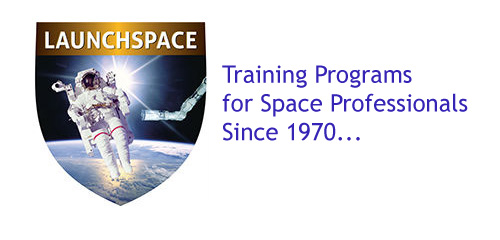Sent from my iPad
Begin forwarded message:
From: "Info@Launchspace.com" <info@launchspace.com>
Date: March 13, 2017 at 8:04:10 AM CDT
To: Bobbygmartin1938@gmail.com
Subject: Aviation Week Article - a New Space Paradigm is BornExplore the Connected World
Reply-To: info@launchspace.com

March 13, 2017Launchspace Training
_____________________________________________________________
2. Pointing Subsystems.
Design and requirements considerations common to pointing systems. High and low precision consideration for bearings, motors and feedback devices.3. Motors.
Stepper motors, DC brush and brushless motor characteristics and behavior. Different motors for suitability against various mechanism applications.4. Feedback Devices.
Optical encoder, inductosyn, resolver and potentiometer characteristics and precision. Selection of feedback devices for suitability against various mechanism applications.5. Bearings and Gears.
Fundamentals of high-precision ball bearings and proper lubrication techniques for long life. Overview of gears with a focus on harmonic drives.6. Lubrication Fundamentals.
Wet and Dry Lubricants. Fundamental behavior, performance and life characteristics of liquid and dry lubricants for space. Different lubrication choices for suitability against various mechanism applications.7. Release Systems and Deployment Systems.
Pyrotechnic and non-pyrotechnic release mechanisms operation and characteristics. Deployment system elements and basics.8. Rotating Signal and Power Transfer Systems.
Slip ring characteristics, operation and behavior.9. Electrical Interfaces.
Interfaces between mechanisms and the spacecraft to give the mechanism designer insight into the implications of important interfaces.10. Structural Dynamics.
Spacecraft and general structural dynamics to give the mechanism designer insight into the structural aspect of mechanisms and into interfaces with larger spacecraft structure developments.11. Structural Metals.
Common structural metals for mechanisms including stainless steel, titanium, beryllium and others. Characteristics of most interest for mechanisms. Materials for springs and bearings.12. Composite Materials.
Common composite materials for mechanisms and characteristics of interest.13. Reliability and Simulation Techniques.
Mechanism simulation techniques and reliability assessment methods.14. Contamination.
Contamination considerations between mechanism and satellite.15. Radiation and Survivability.
Radiation environment and survivability implications for the mechanisms.Instructor: Bill PurdyBill Purdy has 22 years of hands-on experience in the space engineering field with wide-ranging involvement in both spacecraft mechanisms and systems engineering disciplines. Mr. Purdy has been one of the leaders of the space mechanism industry's transition from explosive release mechanisms to non-explosive devices. His involvement in numerous space endeavors includes key roles on over 25 successfully flown spacecraft, work on over 30 flown mechanisms including gimbals, release mechanisms, deployables and many other types of mechanisms. As an educator and space industry consultant to both government and industry, Mr. Purdy applies this broad experience to bring out a clear understanding of the space mechanisms, definition, resolution and integration of mechanism requirements and their relationship to the overall system program success. Mr. Purdy was the Associate Editor of the industry-standard handbook Space Vehicle Mechanisms - Elements of Successful Design and the author of the chapter on non-explosive release mechanisms. He has published seven Aerospace Mechanisms Symposia Papers and was the 1999 winner of the Herzl Award. Mr. Purdy holds a BSME from the University of Maryland._____________________________________________________________________Got One of These?Launchspace Training personnel have been providing special short courses to thespace community since 1970. Early in his career, Dr. Marshall H. Kaplan realized that space professionals had limited resources in advancing their own space-related knowledge base and on-the-job training options. Over the last few decades this company has created and delivered hundreds of focused courses to thousands of engineers, managers and support personnel in the space community. All training subject matter and supporting materials are designed to increase knowledge and improve productivity associated with space technologies, systems and operations. These topics are not offered in a university setting.
Over the past 20 years, Launchspace has been offering company-specific courses that are tailored to the requirements of any given company to train its own personnel. These courses are presented on-site by experts in the particular subject areas. Such offerings have proven to be very cost-effective and efficient. Every major space organization in North America and Europe has taken advantage of Launchspace's Training programs. This includes government agencies such as NASA, USAF and several other offices of the Department of Defense.Course topics cover almost every aspect of space flight from launch vehicle technologies to orbital mechanics to spacecraft design. Our customized courses are offered at client locations in support of mission requirements and to expand the expertise of professional staff members. In addition, a few high-demand public classes are presented for open registration at selected conference locations. Contact us to discuss a customized training program for your professionals:See our website for a partial listing of possible course offerings_______________________________________________________________________________________________LAUNCHSPACE is an educational and consulting organization dedicated to training and continuing education for space professionals and to supporting the space community.We offer the largest array of customized client-site courses to government agencies and industry, and a full spectrum of technical and management expertise in support of space programs. Click on www.Launchspace.com to sign up to receive our weekly articles of timely space events and advances. Also, see our extensive catalog of course offerings. Any of these can be customized for your needs, or we can create a new course for you.Through our training programs we have helped thousands of engineers and managers become more productive in their careers. Our courses and programs are unique and tailored to our clients' needs. We focus on critical skills in all areas of spaceflight, spacecraft and launch systems.Our consulting activities include technical innovation, problem solving, program management, proposal development, systems engineering and litigation expertise. We have been involved with many major space programs over the past 40 years. Our experts span the full spectrum of space challenge areas. We are available to address your needs now and in the future.Please contact us for more information about our services at info@launchspace.comor +1.202.258.6133._______________________________________________________________________________________________
Launchspace Training Phone: 202 258 6133 | Email: Info@launchspace.com



No comments:
Post a Comment